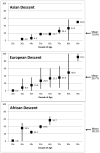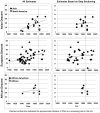Temporal trends and racial disparities in global prostate cancer prevalence
- PMID: 25347377
- PMCID: PMC4955669
Temporal trends and racial disparities in global prostate cancer prevalence
Abstract
Materials and methods: Data from 58 autopsy studies of latent prostate cancer from 1898-2013 were identified and analyzed accounting for histopathological methods, which may have varied over time.
Results: Prostate cancer is most prevalent in African descent men, less prevalent in European descent men, and least prevalent in Asian descent men. Fifty percent of Asian men have latent prostate tumors by 90. This 50% prevalence is reached by age 80 in Caucasians, and by age 60 in African descent men. While men are rarely diagnosed with prostate cancer before age 40, 4% of Asian men, 9% of Caucasian men, and 37% of African descent men have latent prostate cancer before age 40. However, prostate cancer is under-ascertained in Africa. An increase in prostate cancer prevalence was observed by observing historical trends in prostate cancer prevalence. This increase is only significant in men of European descent, who experienced a 0.3% increase in prostate cancer prevalence per calendar year since the 1930's (p = 0.043). Evaluation of incidence-prevalence-duration data suggest that men are living longer with prostate cancer in recent years, perhaps due to early detection and improved treatment. This information has relevance for the design of clinical trials of prostate cancer detection, chemoprevention and treatment, and has been incorporated into recent guidelines for the early detection of prostate cancer and biopsy recommendations.
Conclusions: Prostate cancer is common at all ages and varies by race, and prevalence is increasing over time. Autopsy-based prevalence data provide a means of examining historical trends and comparison of diverse demographic groups and help guide clinical practice and trial design for the diagnosis and treatment of prostate cancer.
Figures
References
-
- Muir E. Carcinoma of the Prostate. The Lancet. 1934:668–672.
-
- Albarran J, Halle N. Hypertrophie et Neoplasies Epitheliales de la Prostate. Annales des Maladies Org Genitoiun. 1898;XVI:797–801.
-
- Ferlay J, Shin H, Bray F, Forman D, Mathers C, Parkin D. GLOBOCAN 2008, Cancer Incidence and Mortality Worldwide: IARC CancerBase No 10. Lyon, France: International Agency for Research on Cancer; 2010.
-
- SEER. Surveillance, Epidemiology, and End Results (SEER) Program. National Cancer Institute; - PubMed
-
- Howlader NNA, Krapcho M, Neyman N, Aminou R, Waldron W, Altekruse SF, Kosary CL, Ruhl J, Tatalovich Z, Cho H, Mariotto A, Eisner MP, Lewis DR, Chen HS, Feuer EJ, Cronin KA, Edwards BK, editors. SEER Cancer Statistics Review, 1975-2008. Bethesda, MD: National Cancer Institute; 2011. SEER Cancer Statistics Review, 1975-2008.
Publication types
MeSH terms
Grants and funding
LinkOut - more resources
Full Text Sources
Medical



